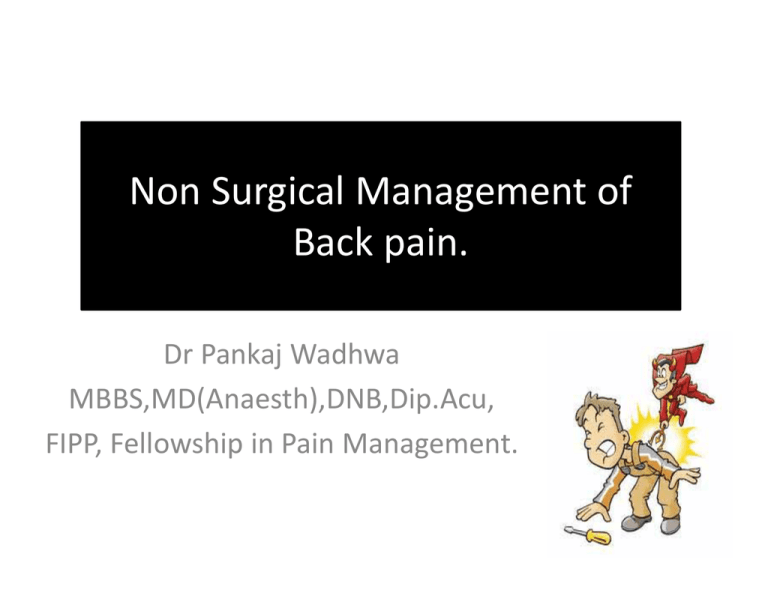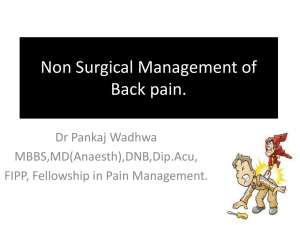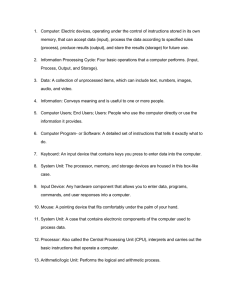Non Surgical Management of Back pain. Dr Pankaj Wadhwa MBBS,MD(Anaesth),DNB,Dip.Acu,
advertisement

Non Surgical Management of Back pain. Dr Pankaj Wadhwa MBBS,MD(Anaesth),DNB,Dip.Acu, FIPP, Fellowship in Pain Management. MAGNITUDE OF THE PROBLEM • It is one of the commonest experiences of humankind. • It affects 60‐80% of the adult population in USA. • Point prevalence is 30% in USA. • It is probably experienced by nearly everyone at some point in his or her life. Interventional Pain management Interventions are Minimally Invasive, Non Surgical and Target Specific procedures to Diagnose and to treat Various painful conditions It fills the gap between pharmacologic management of pain & more invasive operative procedure CAUSES OF BACK PAIN Major causes 1. Facet joint arthropathy 2. Disc disruption/Discogenic Pain 3. Sacro-Iliac joint arthropathy 4. Disc prolapse/ herniated disc/ slipped disc 5. CRPS/ RSD Facet Joint Pain Low back pain- unilateral or bilateral ( Facet joints responsible for spinal pain in 15% to 45% of patients with low back pain) • Referred to the buttocks, groin, hip, or posterior and lateral thigh. • Pain is more prominent in the morning and with inactivity • May aggravate on extension after forward flexion • Tenderness over facet joints • FACET JOINTS SPINAL NERVES PAIN DISTRIBUTION L4 sap L4 TP L3mb man L5 sap L5 TP L4 mb man A B L4 L5 Radiofrequency Ablation • Strong evidence for short term relief ( 6‐ 12mths) • Moderate evidence for long term pain relief(5‐7 yrs) • Excellent and probably only tool for managing facet joint pain • Easy repeatability • Day care SI joint Block/ Radio-Frequency Rhizotomy • SI joint is responsible for at least 13% and perhaps as high as 30% of Low Back Pain. • Percutaneous radiofrequency neurotomy of sacroiliac joints or steroid injection into SI joint provide long-term relief DISC PROLAPSE/ HERNIATED DISC/ SLIPPED DISC Selective nerve root/ Transforaminal epidural block • Diagnostic as well as therapeutic purpose. • Therapeutically it is more effective than ESI. • 10-20mg vs. 40-80 mg in lumber epidural. • If there is epidural scar as in FBSS it is the only route. Transforaminal Transforaminal Steroids Efficacy • Lumbar radicular pain » Confirmed HNP by MRI • LSE without benefit • On surgery schedule • 75% excellent relief up to 10 years • Average ~2 transforaminal injections • Riew et al, J Bone Jt Surg (Am), 2000 − Vad et al, Spine 27:11-16, 2002 Percutaneous Disc Decompression/Discectomy • It is done for disc prolapse & discogenic pain. • Here a 17G needle introduced into the diseased disc under C-arm guidance. • Then a special motorized probe is introduced through this needle & operated. • It breaks the nucleus pulposus into fine particles and sucks it out. Disc Herniation Management : Disc Herniation Percutaneous Partial discectomy +Ozonucleolysis Under fluoroscopic Guidance Correct level of the prolapsed disc is identified . Needle is inserted into the centre of the Disc and decompressor is placed thro the needle. Decompressor Percutaneous Disc Decompression Rotating tip removes small portion of disc material. Because only enough of the disc is removed to reduce pressure inside the disc, the spine remains stable. Insertion site covered with bandage. Recovery is fast as unlike surgical decompression no bone or muscle is cut. 2-3 days of bed rest and may return to normal activity within one week. Ozone Nucleolysis (Ozonucleolysis) • It is a technique of injection of ozone in the disc that brings about a physical shrinkage and reversal of vascular, chemical and biohumoral events that occur in disc herniation and cause radiculopathy • Needs three to four sessions. PDD: advantages • Success rate 80%(Sharps and Issac 2002), • No cut, scar, • No epidural fibrosis, • Stability of normal anatomical structure is maintained. • Hospital stay is less and less costly. Discogenic Pain DISCOGRAPHY Management; Discogenic pain ‐ Intradiscal Ozone Direct Effect of Ozone The gaseous mixture enters then in contact with the deformed discal surface that has altered intermolecular bonds. These bonds are broken by the ozone molecule. At two weeks, ozone stimulates new blood vessel formation in the disc (normally avascular in the adult) and eventually stimulates fibrosis and shrinkage of disc Effect Of Ozone On The Cell-mediated Inflammatory Response Indirect Effect of Ozone inhibiting the synthesis of pro-inflammatory prostaglandins inhibiting the release of bradykinin or paininducing compounds increasing the release of antagonists to the pro-inflammatory cytokines like interleukin 1, 2, 8 and 15 stimulating local production of anti-oxidant enzymes, like catalase, sulfamutase and sod Management : Intradiscal Electrotherapy (IDET) Discogenic Pain –Disc Biaculoplasty POST LAMINECTOMY SYNDROME(FBSS) • • • • • Mechanical causes Epidural fibrosis Arachnoiditis Psychosomatic pain Systemic Medical Illness • NOT AMENABLE TO SURGICAL TREATMENT Epidurogram • Normal Epidurogram looks like an inverted Christmas tree where dye enters into the dural extension of each nerve root. • Filling defect in epidural spread of dye indicate Epidural fibrosis. Epidurogram Normal Filling defect in FBSS Epidurolysis • Epidurolysis/ epidural adhesiolysis/ neuroplasty is done in epidural fibrosis with normal saline/hypertonic saline with/without hyaluronidase. • It may be done with Racz catheter after performing an Epidurogram. Epidurolysis Epidurogram AP view with filling defects. Racz catheter introduced and adhesiolysis carried out. Failed Back Syndrome (FBSS) • Epidural Adhesiolysis Resistant Case of FBSS Treatment of Pain Recovery Operation Strong opioids Weak opioids +/nonNon- opioids +/opioids adjuvant Non-pharmacological methods Treatment of Pain Recovery Operation Strong opioids Weak opioids +/nonNon- opioids opioids World of Misery Non-pharmacological methods Treatment of Pain Recovery Operation Strong opioids Weak opioids +/nonNon- opioids opioids Non-pharmacological methods





